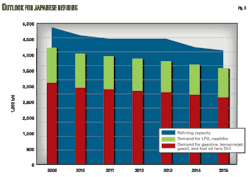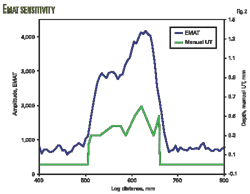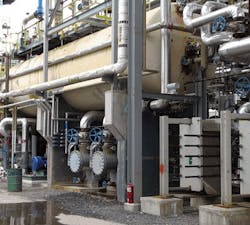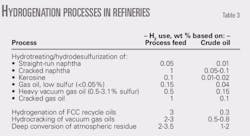Based on an article published in Saudi Aramco Journal of Technology, Winter 2009.
Development of Khurais complex required best practices and leveraged various technologies such as 3D seismic, advanced mathematical modeling, and smart completions.
The Khurais complex is Saudi Aramco's largest intelligent field (I-field) initiative and is the flagship for I-field technologies. Development work reflects both as-needed fit-for-purpose technology applications and long-term vision for the life of the oil assets.
This series of two articles discusses upstream development of the Khurais complex, consisting of several fields and reservoirs capable of producing 1.2 million b/d of Arabian Light crude.
The first article describes the geologic setting, reservoir characterization and modeling, oil-water contact and structural delineation, and advanced mathematical modeling techniques.
The concluding part will discuss design of the horizontal laterals and the intelligent field initiative.
Geological setting
The Khurais complex consists of three fields (Fig. 1). The Khurais area is the largest and was discovered before the two smaller satellite fields, Abu Jifan and Mazalij, which were discovered in the early 1970s. The complex is about 100 miles east of Riyadh.
Although discovered several decades ago, the fields produced only briefly in the late 1980s and early 1990s. Comprehensive development began only during the last couple of years.
The fields have two main oil-bearing carbonate reservoirs: Arab-D and Hanifa, with the Khurais area being the largest in terms of reserves and oil withdrawal rates.
All three fields have similar geological settings, and therefore, the Khurais geologic description provides an understanding for all of the fields.
In Khurais, the Arab-D hydrocarbons are within an elongate, north-south trending, asymmetrical anticline with the lower limits defined by a tight aquifer. The Arab-D reservoir is a few hundred feet thick and consists primarily of clastic limestones, with a lesser amount of fine-grained limestone and dolomite. Zone-1 is considerably better in the upper part of the reservoir compared with the lower Zones 2 and 3.
The Hanifa reservoir lies a few hundred feet below the Arab-D and has lower rock quality with a higher degree of fracturing. Both reservoirs contain Arab Light crude.
Development issues
During the initial development work, several issues loomed large such as:
• How to develop the fields to produce and sustain 1.2 million b/d with peripheral injection?
• How to optimize offtake and development requirements with respect to number of wells and their placements?
• How to identify reservoir communication between Arab-D and Hanifa reservoirs and optimize the production injection strategy between the two reservoirs?
• How to leverage incoming technologies with reservoir uncertainties?
To answer these questions appropriately, the first step involved massive 3D seismic data acquisition throughout the areal extent of the three fields, covering more than 7,000 sq km.
The results from the seismic program improved the definition of the reservoir structure, depth, as well as the characterization of faults and fractures (Fig. 2).
Reservoir characterization
From the subsurface point of view, field development planning begins with geological and reservoir characterization. In the Khurais complex development, this included characterization of cores acquired from several vertical wells. These provided routine core descriptions and porosities and permeabilities of individual layers.
Because the information was sparse, the analysis used stochastic modeling to populate the matrix reservoir parameter arrays. The analysis also included fracture descriptions based on core studies as well as dynamic flow data, pressure transient tests, and drilling information, such as loss-circulation intervals.
Early in field development, work included drilling of horizontal wells for evaluation purposes and acquisition of image logs for fracture assessment and orientation.
The Khurais reservoir contains several types of fractures. The most numerous observed in cores are diffused fractures.1 These are small scale tension fractures sometimes referred to as hairline fractures, microfractures, or background fractures. These fractures are most often bedbound within certain lithologies.
In the Khurais area, diffused fractures are widespread over the entire Arab-D with higher fracture density in the lower zones (Zones 2 and 3) in which matrix porosities and permeabilities are lower than in Zone 1.
Another fracture type appears as fracture swarms, sparse in occurrences and referred to as fracture corridors.2 3 Some of these are conduits for bringing water into the field. They also are referred to as fracture lineaments, derived from curvature analysis.
Khurais does not have large-scale fractures or faults that one can identify the throw on the seismic scale or on walk-away vertical seismic profiles (VSP) conducted in the area.
While cores show a minimal presence of fractures in Khurais, with the exception of diffuse fractures (up to 0.8 fractures/ft), image logs show some fracture swarms (Figs. 3 and 4).
The Rose and Schmidt plots of fractures show a dominant North 80° East to East-West orientation (Fig. 4). These orientations are in agreement with limited fracture lineaments (fracture corridors or swarms) observed from seismic curvature analyses as strike-slip faults with minimal displacements (Fig. 5).2 3 One should note that while the appearance of fractures in Fig. 5 suggests a high fracture density, these lineaments are tens of kilometers apart.
One can also observe these fractures on image logs as clusters of fractures appearing within the same short intervals (Fig. 4). These also correlate well with the dynamic data such as high-flow intervals from low matrix permeability limestone beds. This suggests that the geological and dynamic simulation models should include fractures as one of the driving reservoir parameters.
As a consequence, a decision was made to run the 3D dynamic simulation models in dual porosity-permeability mode to enhance their predictive precision.
Structure delineation
After the geological evaluation, one major task was delineation of the oil-water contact (OWC) and refinement of the reservoir structures in selective areas with limited data.
The Khurais complex development included evaluation wells. These wells serve many purposes such as reservoir data acquisition, OWC and structure delineation for the current development, as well as for future sweep and flood front conformance monitoring.
The program consisted of coring, openhole logging (including image, and nuclear magnetic resonance (NMR) logs), and downhole fluid sampling for fluid characterization as well as establishing a base interpretation for future sweep and recovery assessment.
One highlight was the validation of the similarity of the OWC in both the Arab-D and Hanifa in the Khurais area. This confirmed that both reservoirs are in pressure communication. Also verifying the pressure communication was the common bottomhole pressure (BHP) gradient shown by the two reservoirs that exhibited similar partial pressure drawdown during the limited production period in the past from the Arab-D.
For cost-effectiveness, a series of vertical-horizontal pilot wells (Fig. 6) supplemented and refined the benchmarked 3D-seismic depth interpretations of the structure.
Subsequently, these wells were sidetracked and completed as water injectors. The horizontal laterals were placed just below the OWC for injection effectiveness with respect to pressure supporting the oil producing regions.
The 3D-seismic structure interpretations, combined with evaluation wells and pilot holes, helped in finding an additional small dome oil accumulation in the south of Abu Jifan, which subsequently was included as part of the Khurais complex development.
Similarly, the work delineated the south dome of Abu Jifan as a larger structure than previously mapped.
Advanced modeling
Concurrent with delineation and reservoir evaluation (data acquisition) efforts, optimization of the development plan needed to address several key issues in terms of risk mitigation. Although we faced a wide range of uncertainties in reservoir parameters, we based some major decisions on deterministic solutions derived from analytical, simulation, or mental (engineering judgment) models. These may prove costly because some had very little consideration to the probability and what if scenarios and resulted in actions taken without proper exit strategies.
In these cases, an engineer would build into the decision-making process a safety factor, or cushion, to make certain that failure is not an option. Under certain conditions, it is prudent to do so; however, this could carry a high business cost. The need for an uncertainty analysis for making decision, therefore, is a must.
For example, optimization of production offtake and associated requirements (such as number of injectors and producers, injection production ratio, depletion rates for different areas, sweep and recovery) is difficult because of the nonlinear nature of the optimization problem and the complex interactions between various operational parameters.
In this case, the analysis included a multiobjective function model. Another technical paper discussed the details of the methodology and its utility.4 This article excerpts some of the detail to clarify several points.
In field development, the most important questions and constraints are as follows:
• How much production offtake is optimal from each of the fields and reservoirs?
• What are the most optimal numbers of producers and injectors to be drilled? And what is the optimum well placement?
• How will producers and injectors affect the injection production ratio from each area?
• Does production from each area satisfy its depletion requirement?
• Do we produce or inject too much in areas that have a higher degree of fractures that may cause premature water breakthrough and thereby impair the sweep?
Optimizing these requirements is a difficult task because there are diverging requirements. This means that satisfying one requirement may be at the expense of the others. For example, a higher offtake rate from an area with better reservoir quality means drilling fewer producers for the same target rate, resulting in better developmental economics. This may violate the depletion criteria and may bring in premature water breakthrough, which can impair not only the reservoir sweep and conformance but also hydrocarbon recovery.
Another good example is producing at a depletion rate in an area with insufficient peripheral injection well locations, thereby potentially violating the pressure support requirements and consequently decreasing well productivity. This is where hard and soft constraints come into play and one has to assign weighted constraints.
The most important hard constraint, of course, is the total offtake rate for the increment development. The softest constraint is the number of wells required with the rest falling in between. With this in mind, the analysis divided the total offtake constraint into several areas, each with its specificities in terms of geometry and reservoir quality, in this case three fields and two reservoirs.
As previously mentioned, the hard or primary constraint is the total offtake and sustainability of the oil complex. The engineering analysis determined how much each area can produce by considering the following constraints:
• Keep depletion rate in balance among areas.
• Satisfy the injection production ratio, for example adequate injection has to support production and there must be enough injection wells to support the production.
• Minimize the withdrawal rate in areas with a higher degree of reservoir heterogenieties. A low production rate mitigates possible premature water breakthrough and allows reservoir performance to be observed, and evaluated to formulate optimum completion, and injection production strategy.
• Produce preferentially at a higher depletion rate in low structure areas to promote low structure sweep. This, in turn, lessens the production requirement in the higher structure area, allows better flood front sweep and conformance from low to high structure areas. This is particularly desirable in the case of gravity dominated bottoms-up sweep, as in the case for the reservoirs in the Khurais complex, judging from insights gathered from simulation models as well as from similar neighboring fields.
• Govern the production-injection strategy with prudent reservoir-management practices for oil offtake optimization from each reservoir and area to maximize the production plateau.
The multiobjective function program must optimize all of these constraints with regard to the soft constraint of economics, which is to reduce total development cost by minimizing the number of injectors and producers.
One can accomplished this by drilling wells on a priority basis in the most prolific area first without jeopardizing all other constraints. The key idea is establishment of hard and soft constraints that provide the venue for the optimization of all main requirements, including injection and producing well requirements, injection production ratio, production offtake, and depletion rate for individual areas.
The multiobjective function analysis represents the main focus of field development, such for Khurais.
Development work also included advanced modeling techniques and Monte Carlo simulations in conjunction with multiple realizations of 3D dual porosity-permeability models for development planning, including evaluation of the effect of various reservoir parameters on production using their individual probability functions (Figs. 7 and 8).
In the case of Khurais, the modeling also provided the optimum distance between water injectors and first row producers, as well the design for the electrical submersible pumps (ESPs) by defining the main uncertainties for rock permeabilities (kx and ky), vertical permeabilities (kz), size of the aquifer, relative permeability curves and their end points, viscosity of the fluid, formation volume factors, and bubblepoint pressures.
Reference 4 discussed the details of the modeling. In summary, experimental design and Monte Carlo simulations, together with analytical methods and finite difference models, can be effective in decision making, especially in new field development such as Khurais, beyond their conventional use as tools for probability analysis.
References
1. Bockel-Rebelle, M.O., et al., "Faults, Fracture Corridors and Diffuse Fracturing: Ranking the Main Structural Heterogeneities within Onshore Abu Dhabi Fields," Paper No. 88676, 11th Abu Dhabi International Petroleum Exhibition and Conference, Abu Dhabi, Oct. 10-13, 2004.
2. Ozkaya, S.I., et al., "Devising Knowledge-Base Decision Tree for Detection of Fracture Corridors from Dynamic Data in a Carbonate Reservoir in Oman," Paper No. SPE 105015, SPE Middle East Oil and Gas Show, Bahrain, Mar. 11-14, 2007.
3. Ozkaya, S.I., "Detection of Fracture Corridors from Open Hole Logs in Horizontal Wells," Paper No. SPE 110942, Saudi Arabia Technical Symposium, Dhahran, Saudi Arabia, May 7-8, 2007.
4. Pham, T.R., Al-Ajmi, F.A., and Al-Shehab, M.,"Navigating the Fog of Reservoir Uncertainties to Decision Making with Advanced Mathematical Models in New Field Development," Paper No. IPTC 11978, International Petroleum Technology Conference, Kuala Lumpur, Dec. 3-5, 2008.
The authors
More Oil & Gas Journal Current Issue Articles
More Oil & Gas Journal Archives Issue Articles
View Oil and Gas Articles on PennEnergy.com






